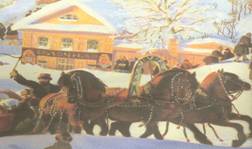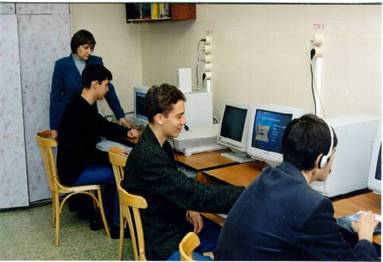

Цели урока:
- Активизировать употребление лексики по теме ‘Shrovetide ‘в устной речи с опорой на репродукцию и текст.
- Развивать эстетический вкус учащихся, приобщая их к обсуждению известного художественного произведения.
- Вызвать чувство гордости за свою страну, приобщая учащихся таким образом к необходимости изучения старинных русских народных традиций.
- Способствовать реализации личностно–ориентированного подхода к обучению;
Оснащение урока:
- Картина Б. Кустодиева ‘Масленица".
- Плакат с комментариями и рисунками по данной теме (под редакцией Р. Энтеля, художники Б. Шулепова, А. Винталюк).
- Компьютерный фильм-презентация: ‘Shrovetide is a folk Russian winter festival"
I. The beginning of the lesson.
Teacher:
Last week we visited a nice Festival, devoted to the winter holiday Shrovetide. It was celebrated not only in the places of our city, but also all around our country. Today we’ll speak about it. What did I ask you to do at home?
Children:
You asked us to. . . . (learn the words and to find the information about the days of Shrovetide.)
II. Lexic drill.
Teacher:
Lets revew the words. Look through the list of words in the screen of your computer. Read them after me.
Srovetide - масленица.
to shrive - shrove – shriven - исповедоваться;
tide - время года; период.
to last - длиться;
deep roots - глубокие корни;
a church - церковь;
to ask for pardon - просить прощения;
to forgive - прощать;
"Troika’- тройка
balloons - воздушные. шарики
ribbons - ленты;
bells - колокольчики;
carriage - of - two - horses - упряжка из 2 - х лошадей;
merry - go - rounds - хороводы;
maskers - ряженые;
buffoons - скоморохи;
pan - cakes - блины; (home-made pan-cakes; street - made pan-cakes;)
to burn down the scarecrow of winter - сжигать чучело зимы;
III Speech practice.
A) Introductory part.
Teacher:
In Russia winter is rich in Festivals. It's time to celebrate though it is cold , frosty and snowy, isn't it?
1) Can you name any winter holidays? (They are New Year's Day, Christmas, Old New Year's Eve, Epiphany and Shrovetide.)
All these festivals have deep roots. But in my opinion nowadays people hardly remember about them. I think they just have fun, say goodbye to winter and welcome spring.
B) A talk about Shrovetide.
2) During what season do people celebrate Shrovetide? (They do it when winter meets with spring).
3) How long does usually "Shrovetide’last?
( --- It usually lasts a week.
--- People usually celebrate "Shrovetide’a whole week.)
4) Can we say that people are looking forward to spring?And what about you? Why are we happy to meet spring?
(Учащиеся просматривают слайды компьютерной презентации с весенними пейзажами и отвечают на вопрос)
(---- Spring is one of the beloved seasons for many people. The air is fresh, the trees are light green, the days are long.
---- Everybody likes to leave the house and breathe in the smells of the first flowers, trees and the ground. The snow is melting.
----- The snow is not very white and bright. We enjoy the quickly running streams around us.
----- Birds are coming back from warm lands and making their nests, animals are preparing their shelters.
--- Spring is a promising time for everybody. It is time of hope for a happier time.)
C) A talk about the days of Shrovetide.
Teacher:
III. Last time I asked you to find the information about the days of Shrovetide.
I want to remember you of days of this nice old Festival. Every day has its own name.
(Учащиеся просматривают слайды компьютерной презентации с изображением и описанием на английском языке каждого дня праздника)
Monday was a ‘Meeting ‘day ("Встреча"). It began at 12 a. m. While housewives made pan - cakes children built snow fortresses, made snowmen. There were snow - battles, sledging down the hills, singing , dancing.
Tuesday was ‘Attracting maids and guys’day ("Заигрыши"). Girls organized singing and dancing in a ring. Young men organized fighting games.
Wednesday was a "Dainty Day" ("Лакомка"). The daintiest food on that day were pan- cakes, a symbol of health, long life and fortune [ ]. There were home made pan - cakes and so- called street made pan - cakes.
Thursday. ‘Broad Shrovetide" ("Широкая масленица ") was the top of the week, the culmination. There were maskers, buffoons, merry - go - rounds, different games.
Friday was a "Mother in Law's parties ‘day ("Тещины вечерки"). On this day only children were out of doors, sledging and playing snowballs. Grownups came out only by the evening to visit the wife's relatives. Mother - in - Law's pan - cakes were most tasty.
Saturday was a day of ‘Daughter- in- Law's Sittings" ("Золовкины посиделки’).
The day was divided into 2 parts. The first part was for making snow- and- ice fortresses. During the second part they went to see husband's relatives.
Sunday was the day of "Parting , Saying good-bye" ("Проводы, прощанье ").
Everyone went to their parents to ask for their pardon - it was Forgiving Sunday
(Прощеное воскресенье). People arranged rich Festivals of parting with winter and meeting with spring.
D - A work with the picture.
Look at the picture. Let's describe it together. Please listen to my questions and answer them.
1) What kind of painting is this? (It is a landscape. )
2) Who is the picture created by? (It is created (painted) by Russian famous artist
Boris Kustodiyev.)
3) What is portrayed in the picture? (The Russian winter folk holiday (festival)
Shrovetide is portrayed in the picture).
4) What is the colour of the landscape? (The colour is bright and sunny).
5) It is late winter, isn't it? I think the weather in the picture is beautiful.
What makes it beautiful? (The snow ,the sky, the sun make it beautiful.)
6) So we see the Old Moscow's square.
And what do you see in the middle of the square? (In the foreground we can see a horse harnessed in a sledge. It is ‘Troika’with the ribbons and the bells.
7) What is painted to the right?
(---There is an old theatre building and a lot of people everywhere.
--- Behind the theatre there are merry - go - rounds.
--- People are dancing and singing merry songs.
--- Tasty things and balloones are sold here.)
8) And what about the left side of the square? (We can see there one - or - two-horse carriages with merry people inside.)
9) Describe the weather please.
---- It is late winter now. The day is frosty.
---- The sky is cloudless. The sun is shining brightly, though it doesn't warm.
---- Everywhere we can see much snow. Leafless trees with heavy “caps “of snow decorate the landscape.
---- It is a great pleasure to make snowmen, to skate, to ski or sledge in such fine weather!
Teacher:
Imagine, you are warmly clothed. You are sitting in a sledge and a fast horse is carrying you along a forest road. The gold sun is shining brightly. You are looking at the sky, at the white and silver trees.
Aren’t you happy? (Yes, of course.)
10) What can we cee in the background?
(---- There is a church on the hill.
---- We see people going to and from the church.
---- We see children sledging down the hill and making snowmen, playing snowballs.
11) I think the artist has created a good holiday mood for people to see and to be proud of old Moscow, hasn't he?
(Yes , of course. We can say that the painting arouses some merry holiday feelings.)
Teacher:
V. Describe the picture, please.
Use the plan on the blackboard: (план высвечивается на дисплее компьютеров)
1. Who created. . . .? What is portrayed. . .? The colour of the painting. .
2. The weather.
3. The old Moscow's square:
a) the foreground;
b) the right side of the picture;
c) the left side of the picture;
d) the background.
4. --The mood of the picture;
-- the people's feelings.
Pupils:
1. It is a landscape. It is created (painted) by Russian famous artist Boris Kustodiyev. The Russian winter folk holiday (festival) Shrovetide is portrayed in the picture. The colour of the picture is bright and sunny.
2. It is late winter. --The snow, the sky, the sun make winter beautiful.
----The day is frosty. The sky is cloudless. The sun is shining brightly, though it doesn't warm.
---- Everywhere we can see much snow. Leafless trees with heavy “caps “of snow decorate the landscape.
---- It is a great pleasure to make snowmen, to skate, to ski or sledge in such fine weather!
3. So we see the Old Moscow's square.
a) In the middle of the square we can see a horse harnessed in a sledge.
It is “Troika’ with the ribbons and the bells.
b) To the right there is an old theatre building and a lot of people everywhere.
Behind the theatre there are merry - go - rounds.
People are dancing and singing merry songs.
Tasty things and balloons are sold here.
c) In the left side of the square we can see there one - horse carriage with merry people inside.
d) In the background there is a church on the hill.
---- We see people going to and from the church.
---- We see children sledging down the hill and making snowmen, playing snowballs.
4. The artist has created a good holiday mood for people to see and to be
proud of old Moscow . We can say that the painting arouses some merry holiday feelings.)
IV. Summing up.
Teacher:
Now let’s sum up everything we have learnt about the nice winter folk holliday Shrovetide.
1) First read the sentences in turn. (учитель раздает учебные карточки)
Pupils:
Shrovetide is the time of
seeing of winter and meeting spring.
going to the church.
asking for pardon and forgiving.
merry singing and dancing in a ring.
organizing different winter games.
playing snowballs.
sledging down the snow-hills.
making and eating pancakes.
maskers, buffoones[ ],
merry- go - rounds.
burning down the scarecrow[ ] of winter.
hopes.
Teacher:
2) At our lesson you answered different questions and described the picture, we read about the days of Shrovetide. And now I'd like you to tell me about Shrovetide.
VI. Teacher:
Be ready to remember your home task for the next lesson/
An American friend came to Russia. You are speaking about Russian winter festivals. You tell him about Shrovetide. Make up a dialogue (6 or 7 phrases in each part).